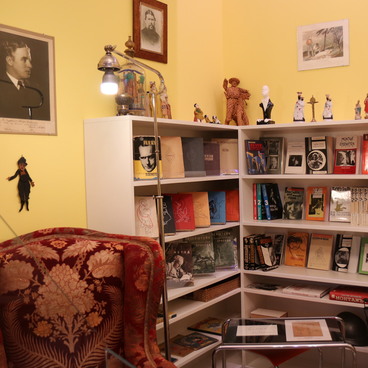Calming colors converge in the library room. Chippendale chair and armchair are upholstered in blue, the walls are also painted blue. There is a green brocade tablecloth on the round table. Open shelves without glass doors and a stepladder were designed and commissioned by Eisenstein in 1935. Bright pillows on the chairs were also personally commissioned by the director to be sewn from the farmer fabric he purchased in Kharkiv in the 1930s.
A wide range of Eisenstein’s interests is reflected in the books found on the shelves. There are Russian books there, as well as foreign publications. Eisenstein was fluent in German, English and French since childhood; he learned Spanish in Mexico; he could comprehend Italian, and even dabbled with learning Japanese when he was young. Belles-lettres and scientific literature are standing side by side on these shelves: art history, art theory, psychology, psychoanalysis, sociology, anthropology, natural sciences, and many other topics are explored by these books.
At the end of the shelf on the right is the death mask of Alexander PUshkin, a 20th-century casting from the 1837 form created by Samuil Galberg. Pushkin was the artistic and moral guide for Eisenstein. The director even considered creating a movie about him: “Poet”s love”. Reproductions of sketches for this project and other drawings from different years are displayed on the shelves.
Round table and carven oak chairs used to belong to Eisenstein’s mother, YUlia Eisenstein (formerly Yulia Konetskaya). In 1935, Yulia Ivanovna Eisenstein moved into his son’s former room in a communal apartment on Chistiye Prudi. She passed on several items to her son for his new apartment on PotYlikha Street, including this desk.
Eisenstein’s portrait painted by AlIce ErnestIne Prin /pren/, also known in the art history as KikI de MontparnAsse, is hanging on the blue wall. They met in Paris, and Eisenstein posed for Kiki in late 1929.
Eisenstein considered artists and thinkers throughout the human history his ‘conversation partners in the ages.’ Three portraits of his ‘conversation partners’ are on the connecting shelf between the two racks on the left. They are: theatre reformer and French actor Frederic-Lemaitre, French artist Edgar Degas, and the ancient Greek philosopher Socrates.
Contemporaries of the director were also included into his ‘spiritual family.’ Their signed photographic portraits were hanging on the sides of the shelves in Eisenstein’s Potlylikha apartment. In the exhibition these portaits are handing on the glass barriers. Left: French avant-garde filmmaker Abel Gance as Christ in his film “End of the World”; the African American singer and actor Paul Robson; American conductor Leopold Stokowski, who orchestrated the music for Disney animated features; luminary of the Beijing Opera Mei Lanfang. Right: Mexican artist Jose Clemente Orozco; Danish-German film star Asta Nielsen; physicist Albert Einstein; writer James Joyce.
On the right wall there is a carpet of corn straw with the inscription “Viva Mexico”: a memento from the country where the director, together with his associates Grigory Alexandrov and Eduard Tisset, shot the movie “Long Live Mexico! ” In 1931, remnants of unfinished movies and projects also inhabit the House of the Master.
A wide range of Eisenstein’s interests is reflected in the books found on the shelves. There are Russian books there, as well as foreign publications. Eisenstein was fluent in German, English and French since childhood; he learned Spanish in Mexico; he could comprehend Italian, and even dabbled with learning Japanese when he was young. Belles-lettres and scientific literature are standing side by side on these shelves: art history, art theory, psychology, psychoanalysis, sociology, anthropology, natural sciences, and many other topics are explored by these books.
At the end of the shelf on the right is the death mask of Alexander PUshkin, a 20th-century casting from the 1837 form created by Samuil Galberg. Pushkin was the artistic and moral guide for Eisenstein. The director even considered creating a movie about him: “Poet”s love”. Reproductions of sketches for this project and other drawings from different years are displayed on the shelves.
Round table and carven oak chairs used to belong to Eisenstein’s mother, YUlia Eisenstein (formerly Yulia Konetskaya). In 1935, Yulia Ivanovna Eisenstein moved into his son’s former room in a communal apartment on Chistiye Prudi. She passed on several items to her son for his new apartment on PotYlikha Street, including this desk.
Eisenstein’s portrait painted by AlIce ErnestIne Prin /pren/, also known in the art history as KikI de MontparnAsse, is hanging on the blue wall. They met in Paris, and Eisenstein posed for Kiki in late 1929.
Eisenstein considered artists and thinkers throughout the human history his ‘conversation partners in the ages.’ Three portraits of his ‘conversation partners’ are on the connecting shelf between the two racks on the left. They are: theatre reformer and French actor Frederic-Lemaitre, French artist Edgar Degas, and the ancient Greek philosopher Socrates.
Contemporaries of the director were also included into his ‘spiritual family.’ Their signed photographic portraits were hanging on the sides of the shelves in Eisenstein’s Potlylikha apartment. In the exhibition these portaits are handing on the glass barriers. Left: French avant-garde filmmaker Abel Gance as Christ in his film “End of the World”; the African American singer and actor Paul Robson; American conductor Leopold Stokowski, who orchestrated the music for Disney animated features; luminary of the Beijing Opera Mei Lanfang. Right: Mexican artist Jose Clemente Orozco; Danish-German film star Asta Nielsen; physicist Albert Einstein; writer James Joyce.
On the right wall there is a carpet of corn straw with the inscription “Viva Mexico”: a memento from the country where the director, together with his associates Grigory Alexandrov and Eduard Tisset, shot the movie “Long Live Mexico! ” In 1931, remnants of unfinished movies and projects also inhabit the House of the Master.

